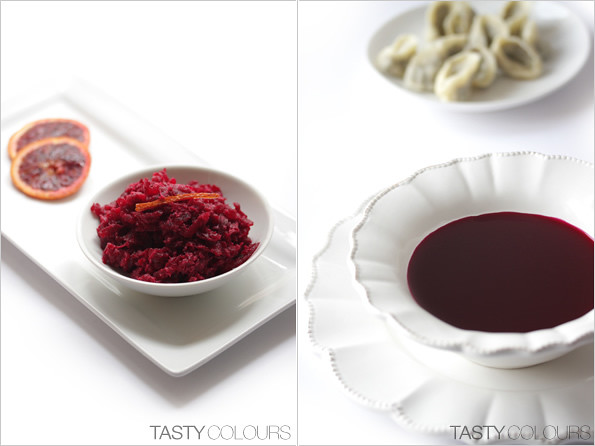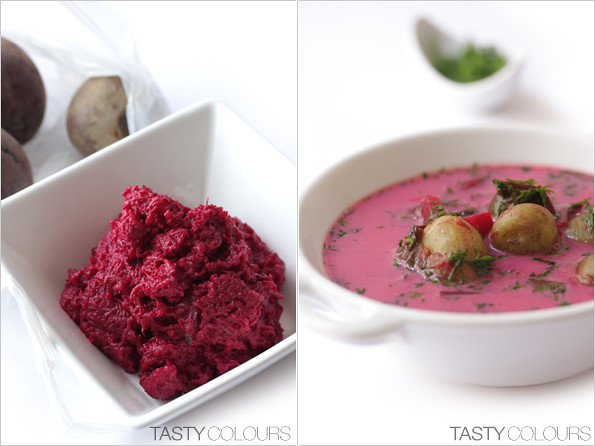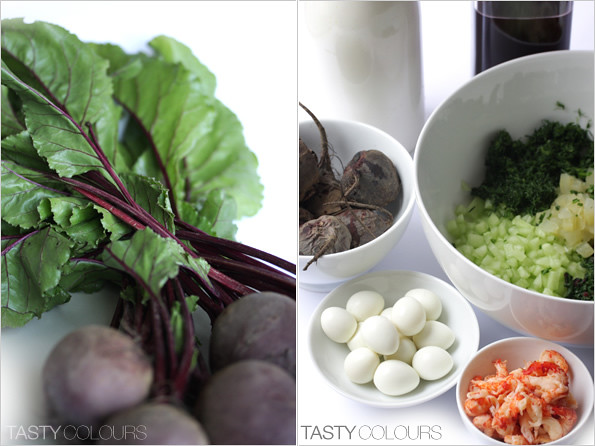This is a post for those who are beetroot lovers, like me. This is a post for those who do not measure the Glycemic Index or for those who do not care about the Montignac diet program. This is a post for those who adore dirty jobs and do not make faces once they have to peel red and bloody beets.
These bad beets are one of the most popular vegetables in Poland. In fact, they are so common that the word itself (beetroot – burak) has a second meaning which describes a peasant or a person who behaves primitively.
Beets are eaten all year round in my country. We, Polish people, pickle beets, for example, with garlic. Sour beet starter is the base for one of version of “borsht”, which is a one of the most popular soups in Poland, especially served with raviolis stuffed with ceps for the Christmas Eve. Warm beet puree is served traditionally as an accompaniment to meat dishes, for example, Zrazy.
Cold beetroot and horseradish salad called Ćwikła, is often served as an accompaniment to Easter dishes, in particular cold meats and pates. Young beets, with their leaves and stalks, which you can get only in summertime, are used for “botwinka” – a soup made out of young beets.
Those, who are familiar with Polish cooking, probably already noticed that I have not yet mentioned “chłodnik litewski” (in direct translation from Polish - “Lithuanian cold soup”), which is a soup traditionally eaten cold and which is always served in summertime. It is made from young beets, their leaves and stalks, sour milk (buttermilk or kefir), freshly chopped herbs and some raw chopped vegetables.
This absolutely tasty and vivid pink cold soup, in its today’s "luxury" version served with crayfish tails and quails’ eggs, is not less original and tasty than internationally known cold soups, for example Spanish Gazpacho.
It is totally refreshing; slightly acid and having an extremely pink color. In summertime, in Poland, one can taste its more rustic version everywhere, meaning in every canteen, cheap and fast restaurants and other more sophisticated places as well. It is a huge, huge pity, that the soup is not known anywhere else in the world.
Well, why is this soup called “Lithuanian”? Probably because it came ages ago from Lithuania. As I already mentioned it in my Zrazy recipe, for ages, Poland was with Lithuania in a political union and that is one of reasons why we are influenced by its culinary traditions.
Nowadays the soup is so popular, that I do not feel any discomfort presenting it as one of typical, Polish dishes.
I prepare it very often in the summer, when young beets are available at every food market (at least in Poland, in Paris you will not find them so easily). There exist various ways to prepare this soup. However, you will always need young beets with their leaves and stalks, sour milk (buttermilk or kefir; or even natural yoghurt, if you cannot find any of the three products)). In old recipes it is advised to add a lot of fresh sour cream which, nowadays, may seem excessive because it is too rich. I add just a bit, and not always.
Then you have to buy cucumbers, fresh chives and dill (if you do not like dill, you can use more chives). A bit of something sour is advised – most likely, some Polish-style beetroot concentrate, or Polish-style sour cucumber’s juice. But remember! If you cannot find any of those ingredients, just add a bit of a fine vinegar (for example, red wine vinegar) or lemon juice, or just omit it (the soup will still be good!). A traditional version for this soup does not contain any garlic, but I know people who add some of it. Other people add chopped radishes and Polish-style pickled cucumbers, too.
Nowadays the most popular accompaniment to the soup is hardboiled eggs or potatoes. However, one could remember that one hundred years ago it was often served with cooked crayfish tails or some baked meat (for example, veal).
In my recipe, I bake one half of the beets and I use the second half to prepare the beet broth* (in my opinion, beets cooked in water lose a lot of their taste. I add the baked beets into the soup, cut into slices).
This is an exquisite version of the rustic soup - I recommend it to all of you who like beets! Bon appétit!
Cold beet soup (Chłodnik litewski)
Serves 4
Ingredients:
1 l sour milk (or buttermilk, kefir or natural yogurt - to buy in food stores carrying Polish or Russian food)**
100 ml crème fraiche (optional)
3 young beets (around 300-350 g), washed and dried (for baking)*
2 young beets (around 200 g), peeled, washed and cut into slices*
5-6 stalks of young beets, washed and cut into halves*
2 handfuls of young beets’ leaves, washed and chopped
3 small size pickling cucumbers or 1 medium cucumber, peeled, washed and chopped into very small cubes (around 200 g)
1 bunch chives, finely chopped
1 bunch dill, finely chopped
2 to 3 tablespoons red wine vinegar (or 100 ml Polish-style sour beet concentrate or sour cucumbers’ juice, but it is not so easy to buy) (optional)
8 to 10 hardboiled quail’s eggs (or 4 regular hardboiled eggs)
120 g crayfish meat (optional)
Salt
Pepper
A pinch or two powdered sugar
Preparation:
Preheat your oven until 180 degrees.
Place 3 beets in the oven and bake them until soft, for about 30 to 40 minutes depending on their size (check if they are baked with a fork).
Remove the beets from the oven, let them cool down completely, peel them and cut them into cubes or slices and put aside.
In the meantime, in a pan, bring to a boil about 500 ml of water. Add the remaining raw beets and stalks and cook until completely soft. The beets broth will have a deep, nice color. A last, add the beet’s leaves to the broth and cook for another 5 minutes. You should have about 250 to 300 ml of broth.
Strain the broth, throw away the beets and, eventually, stalks (at least I do not eat cooked stalks, because I do not like them). Reserve the leaves. Let the liquid cool down completely.
In a large bowl, mix buttermilk with cream.
Add chopped cucumbers, beets leaves, dill and chives. Mix everything.
Then start to add slowly little by little the beets broth, mixing and controlling the color and texture of the soup.
Add the sour beet base or red vinegar (should you want to use any), season with salt, pepper, sugar and mix.
The color of this soup should be intense pink.
The soup should a bit thick, rich in ingredients.
Place the soup in the fridge for at least one hour.
Serve it cold with baked beets, eggs and crayfish meat.
Note: this soup tastes even better when served on the next day.
*You may, however, simplify this recipe by cooking slices of peeled beets, their stalks and leaves together in water. This is how the beet base is usually prepared.
**if you cannot find any sour milk, kefir or buttermilk, you can try to use natural, liquid yogurt.
Cost:
Buttermilk: 2.20 €
Organic young beets: 3.90 €
1 pack of crayfish (cooked): 3,20 €
1 pack of crayfish (cooked): 3,20 €
Quails eggs: 3.00 €
Chives: 1 €
Dill: 1 €
Cucumber: 1 €
Other ingredients: 1 €












27 comments:
Masz rację, polski litewski chłodnik zasługuje na światową sławę. To jest Żurek letnich miesięcy! Cudne zdjęcia, jak zawsze.
przeze mni wielbiony od dziecka :)
ma wspaniały kolor!
Les betteraves! At last!
Not that your earlier posts were in any way inferior, but this one is your pièce de résistance so far. C'est magnifique! The colors, the shapes, the arrangement, those seafood tails and that egg atop them. You have truly brought the common beet into the palace.
While the use of this root veg in the West might still be considered a fancy novelty and a good grounds for overcharging patrons in posh restaurants, this deep red fella is such a commoner that indeed it's name in Polish is used to describe a peasant, and less than noble behaviour. (Feudal traditions are still present in our culture, and a mere suggestion of someone's rural heritage is considered an act of offence, the honor of the offended to be restored only by duel ;o))
The red color of it, so deep it is often used as dye resembles the tan on faces of those who work outside mainly, exposed to the whims of elements, therefore "a burak" would be equivalent of a redneck. But, as I noticed some time ago, the word itself is similar to German "bauer", or Dutch "boer", both meaning a farmer or a peasant. Maybe this be the source of this invective.
But I drifted of again, I'm sorry. Where was I? Oh, the beetroot!
Glycemic Index? Montignac Diet? Get outta here! That's something good for people who have lost their own taste, the basis of sound judgement and the ability to reason. If someone's so confused in this world that they don't trust their own instincts, cannot decide what's best for them only by looking at it, smelling and tasting, than all King's men won't help them with their dietary regimes. Dear foreigners (to this vegetable): Beets are good! Trust the Poles on this one. And Magda's soup must be the most beautiful beetroot creation that I have ever seen. And I sure hope to taste one fine day.
Lidko, wedlug mnie tez zasluguje choc na odrobine docenienia, o :). Ta zupa szczegolne miejsce zajmuje w moim sercu i dlatego tez chcialam sie postarac, aby jak najpiekniej wygladala.
My, dzieki, ze wpadlas. Chlodnikozercy wszystkich krajow laczcie sie...!
I absolutely LOVE beets! I do not understand people who do not like beets!
Now thanks to you I can widen my repertoire of Beet-recipes! I did not know they were so popular in Poland.
To answer your question, it is very difficult for me to recommend one dish over another; I don't know what your friends or relatives like! My suggestion is just to browse and click on something that appeals to you. It also depends on what is available in Poland.
Have a great holiday!
I really loved this post! Not only did you give us a great recipe we got to learn something as well. I really enjoy your blog and will be back as ofte as is possible. I hope you are having a wonderful day. Blessings...Mary
I love beets under any form or shape, and I know I would love this soup. Beets are popular in Eastern Europe, so many wonderful ways to prepare them. When I look at the cost of groceries, I forgot how cheaper it is in Europe, my goodness I bought a few apples today for $12, and a bag of cherries for $10. That is ridiculous.
I am a beet lover! And a lover of your soup. I've seen beet soups before and they usually only have a few ingredients in them. This one has tons of flavor! And some ingredients that are unique to me. Thanks for sharing all your interesting information.
Przepiekne zdjecia. Jestem pod ogromnym wrazeniem. Chlodniku litewskiego prawde mowiac jeszcze nie jadlam i nie robilam. Na pewno wiele stracilam wiec zamierzam niedlugo to nadrobic :)
Pozdrawiam.
This post will change the mind of these non-beetroot eaters! Looks gorgeous and sounds just delicious! Love these stunning and mouthwatering pictures.
Magdaleno, gratuluję Ci wspaniałego promowania kuchni polskiej! Piękne zdjęcia :)
Majko, trudno uwierzyć, że nie jadłaś nigdy chłodnika litewskiego, szczerze polecam, o ile lubisz buraki i te kombinacje smakowe, rzecz jasna. Dziękuję za komplementy i wizytę na blogu.
Quinoamatorko, dzienks. Wielu ludzi pewnie się puka w głowę, ale to taki mój konik. Mam wrażenie, że większość myśli, iż polska kuchnia nie ma niczego ciekawego do zaprezentowania światu. Pozdrawiam.
Hi, Szalony ! Oui, les betteraves ! Elles sont délicieuses !
Thanks for complimenting me. But you are right as regards the other meaning of the “beet” word. I will adjust my post accordingly.
I wanted to present this soup already three weeks ago, but I could not find any young beetroots in my neighborhood. I bought them only last week and here you have them!
Beets are known in French cooking, but to my surprise, in a non-appetizing version. When I was working in the Alsace region, they were always served cooked and cut in cubes in a cantina – and that’s it. I can understand why so many French do not like them.
Now, the red and common fella is served in fancy restaurants, as other forgotten and “ancient” vegetables. Famous chefs create sophisticated starters or medieval variations. The beets appeared even on covers of fancy French food magazines.
I entirely share your opinion as regards the Glycemix Index and Montignac diet. Get outta here and never come back!
Take care Kucharsz, and thanks so much for you incredible comment!
Tasteofbeirut: It is great that you love beets! I will present more beet recipes in coming weeks. Take care !
Mary: thanks, I appreciate this a lot. I will try to present other interesting and regional food and dishes, with some information that maybe will be useful. Have a good day, too.
Angie; thanks for visiting the blog but unfortunately I am not so convinced if my post will change the mind of these non-beetroot eaters. My aunt, for example, who does not like beets, told me that my beets looked great, but this did not convinced her to eat them !
Cinnamon_Girl: that’s great that you love beets, because they are delicious (pity for those who do not like them). This version of the cold soup is quite unique, its daily version comprises usually hard boiled eggs (which is delicious, too).
Citronetvanille: nice to read that you like those awful beets, too. Fruits and vegetables are cheaper in Poland, than in France, in particular in the season. But at the same time, people do not earn so much money. However, twelve bucks for few apples sounds really expensive!
I love beets, I love soups and obviously I love your pictures. ;) I use to make my own sour beet concentrate in Poland (it is rich in iron) and looks like I have to start making this again, because I miss this taste so much. This souo is definately worth trying!
Sleep well!
Magda, you've made my day ! Not knowing about your new cold beet soup post until, Today I went to a small Warsaw farmers market and I bought me all ingredients for chlodnik litewski, including few crayfish! I cooked botwinka and after one hour soup was ready (kefir-based).
Just a few remarks. You're absolutely right about the final color of the soup. It has to be as pinkt as old grandma underwear. But to preserve the color for a day or two, I always add slices of baby beets to the bowls with soup, not to the pot. If you put the beets into entire soup, they will deepen the redness quickly - so keep them away and add to the soup served just a few minutes before.
Also, you write you discard baby beets (botwinka) stalks. Wrong ! The very sense of botwinka is that it's entirely edible after cooking. Beets, stalks, leaves... you're just eating late spring flavour... In addition, stalks, if not overcooked, add wonderful soft crunchiness to the meal.
Last but not least: old Lithuanian recipes used to mention small chunks of the cold veal roast to be put into this absolutely gourmet soup. Hell with simplistic gazpacho, long live CHLODNIK !
Daddy
Hello Daddy,
it is nice to see you here.
You,re right about preserving the color of the soup; it's true if you keep this soup for a day or two; but in my home, it disappears the same day...I will add a footnote to the recipe.
As regards stalks: stalks should be added, that's also true. The only problem that I do not like them, as opposed to leaves. That's why I throw them away That's what I meant in my post, but maybe I did not expressed myself quite clearly. Take care!
I am so glad you posted this recipe! I have always wanted to make this soup and I know your recipe is a great and traditional one!
We made a very similar chilled beet soup growing up in Ukraine too. Love it!
5StarFoodie - yes, in Ukraine you have similar chilled soups. Thanks for visiting!
Karolina: it is supposed to be rich in iron, this sour beet starter. thanks for commenting.
What a wonderful post! I found you through my site and I am so impressed! I have you bookmarked. Have a wonderful day!
I love, love, love beets so I know I would love your soup! It's beautiful!!
Inspired...beats are great! If you like them, maybe you will make it one day!
Oh, we would love this soup. Your garnish is gorgeous too.
LL
This Beet soup is really impressive. Beautiful colors, beautiful pictures. Great post.
Lori Lynn, Gitte:
thanks for visiting my blog. If you like beets, I recommend it to you.
What a nice post about one of my favorite soups. I make the traditional Lithuanian version, without the quail eggs and crayfish, and I can see how appealing this variation would be. My mother always made it with buttermilk and sour cream to enrich it a bit. I now make it with home-made kefir. Sometimes I make it without the beets for a white version - very refreshing. A couple of comments. For Lithuanians the mandatory accompaniment would be boiled potatoes sprinkled with chopped dill. Also, if you do use eggs but anticipate refrigerating leftover soup, add the eggs to the individual serving bowls only. Eggs turn quite unpleasant when left to stand in the soup for a longer time.
I enjoy your blog and look forward to future posts.
Hello Dyonyte, thanks for visiting my blog. You are right about potatoes - also in Poland often this soup is accompanied with potatoes. The eggs always to the indivudual servings, otherwise they change their colour. Good luck !
Post a Comment